名词复数形式的变化规则.
英语名词单数变复数规则

英语名词单数变复数的规则一、绝大多数的可数名词的复数形式,是在该词末尾加上后辍-s。
读音变化:结尾是清辅音读[s],结尾是浊辅音或元音读[z]。
例:friend→friends; cat→cats; style→styles; sport→sports; piece→pieces二、凡是以s、z、x、ch、sh结尾的词,在该词末尾加上后辍-es构成复数。
读音变化:统一加读[iz]。
例:bus→buses; quiz→quizzes; fox→foxes; match→matches; flash→flashes三、以辅音字母+y结尾的名词,将y改变为i,再加-es。
读音变化:加读[z]。
例:candy→candies;daisy→daisies;fairy→fairies; lady→ladies;story →stories四、以-o结尾的名词,如果不是外来词或缩写,就加-es,否则加-s构成复数。
读音变化:加读[z]。
例:tomato→tomatoes; potato→potatoes; torpedo→torpedoes; bingo→bingoes反例:silo→silos; piano→pianos(外来词); photo→photos; macro→macros(缩写词)五、以-f或-fe结尾的名词,多为将-f或-fe改变为-ves,但有例外。
读音变化:尾音[f]改读[vz]。
例:knife→knives; life→lives; leaf→leaves; staff→staves; scarf→scarves反例:roof→roofs六、以-us结尾的名词(多为外来词),通常将-us改变为-i构成复数。
读音变化:尾音[Es]改读[ai],其中[kEs]要改读为[sai],[gEs]要改读为[dVai]。
例:fungus→fungi; abacus→abaci; focus→foci; cactus→cacti;cestus→cesti七、以-is结尾的名词,通常将-is改变为-es。
名词复数形式变化规则

e r
sheep---sheep child---children foot---feet knife---knives wife---wives tomato---tomatoes hero---heroes box---boxes
Homework
合成名词是否也有复数?如果 有,那应该怎么变呢?
A n
• • • • • • • • map---maps tree---trees book---books photo---photos potato---potatoes watch---watches mouse---mice baby---babies
s w
• • • • • • • •
goose-geese foot-feet tooth-teeth
二、老鼠虱子也易记,ouse 变 ice mouse-mice louse-lice
三、孩子加上ren,美人鱼鹿绵羊不用变
child-children
people-people deer-deer fish-fish sheep –sheep
定义
名词:表示人、事物或者抽象概念 的词叫做名词。
规则变化
一、大多情况,词尾直接加-s
newspaper-newspapers book-books card-cards
apple-apples cat-cats
magazine-magazines
二、以s,sh,ch,-buses watch-watches box-boxes
dress-dresses brush-brushes buzz-buzzes
三、辅音字母+y结尾的名词,y变i再加es
family-families
名词单数变复数变化规则

名词单数变复数变化规则:一、绝大多数的可数名词的复数形式,是在该词末尾加上后辍-s。
读音变化:结尾是清辅音读[s],结尾是浊辅音或元音读[z]。
例:friend→friends; cat→cats; style→styles; sport→sports; piece→pieces二、凡是以s、z、x、ch、sh结尾的词,在该词末尾加上后辍-es构成复数。
读音变化:统一加读[iz]。
例:bus→buses; quiz→quizzes; fox→foxes; match→matches; flash→flashes三、以辅音字母+y结尾的名词,将y改变为i,再加-es。
读音变化:加读[z]。
例:candy→candies; daisy→daisies; fairy→fairies; lady→ladies; story→stories四、以-o结尾的名词,如果不是外来词或缩写,就加-es,否则加-s构成复数。
读音变化:加读[z]。
例:tomato→tomatoes; potato→potatoes; torpedo→torpedoes; bingo→bingoes反例:silo→silos; piano→pianos(外来词); photo→photos; macro→macros(缩写词)五、以-f或-fe结尾的名词,多为将-f或-fe改变为-ves,但有例外。
读音变化:尾音[f]改读[vz]。
例:knife→knives; life→lives; leaf→leaves; staff→staves; scarf→scarves反例:roof→roofs六、以-us结尾的名词(多为外来词),通常将-us改变为-i构成复数。
读音变化:尾音[Es]改读[ai],其中[kEs]要改读为[sai],[gEs]要改读为[dVai]。
例:fungus→fungi; abacus→abaci; focus→foci; cactus→cacti; cestus→cesti七、以-is结尾的名词,通常将-is改变为-es。
英语名词变复数变化规则
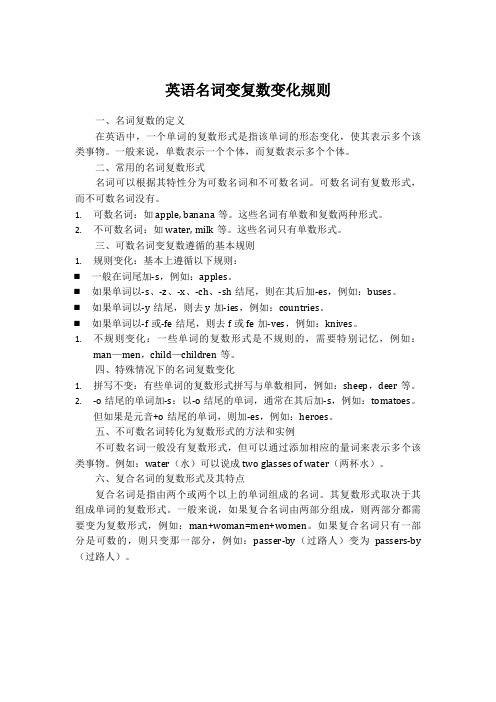
英语名词变复数变化规则一、名词复数的定义在英语中,一个单词的复数形式是指该单词的形态变化,使其表示多个该类事物。
一般来说,单数表示一个个体,而复数表示多个个体。
二、常用的名词复数形式名词可以根据其特性分为可数名词和不可数名词。
可数名词有复数形式,而不可数名词没有。
1.可数名词:如apple, banana等。
这些名词有单数和复数两种形式。
2.不可数名词:如water, milk等。
这些名词只有单数形式。
三、可数名词变复数遵循的基本规则1.规则变化:基本上遵循以下规则:⏹一般在词尾加-s,例如:apples。
⏹如果单词以-s、-z、-x、-ch、-sh结尾,则在其后加-es,例如:buses。
⏹如果单词以-y结尾,则去y加-ies,例如:countries。
⏹如果单词以-f或-fe结尾,则去f或fe加-ves,例如:knives。
1.不规则变化:一些单词的复数形式是不规则的,需要特别记忆,例如:man—men,child—children等。
四、特殊情况下的名词复数变化1.拼写不变:有些单词的复数形式拼写与单数相同,例如:sheep,deer等。
2.-o结尾的单词加-s:以-o结尾的单词,通常在其后加-s,例如:tomatoes。
但如果是元音+o结尾的单词,则加-es,例如:heroes。
五、不可数名词转化为复数形式的方法和实例不可数名词一般没有复数形式,但可以通过添加相应的量词来表示多个该类事物。
例如:water(水)可以说成two glasses of water(两杯水)。
六、复合名词的复数形式及其特点复合名词是指由两个或两个以上的单词组成的名词。
其复数形式取决于其组成单词的复数形式。
一般来说,如果复合名词由两部分组成,则两部分都需要变为复数形式,例如:man+woman=men+women。
如果复合名词只有一部分是可数的,则只变那一部分,例如:passer-by(过路人)变为passers-by (过路人)。
名词复数的变化规则

名词复数的变化规则:1、一般情况下,名词复数直接加sdesk s(书桌)hamburger s(汉堡包)girl s(女孩)monkey s(猴子)2. 以s, x, sh, ch结尾的名词,复数形式加es,如:class es(班级,课,同学们)glass es(玻璃杯,眼镜)box es(盒子,箱子)watch es(手表) dish es(碗碟)dress es(连衣裙) peach es(桃子)fox es (狐狸) sandwich es三文治)match es(比赛)3. 以y结尾的名词,复数形式有两种:a.辅音字母+y结尾,改y为i再加eslad y—lad ies(女士)bab y--bab ies(婴儿)cand y—cand ies (糖果) cit y—cit ies(城市)famil y—famil ies (家庭)b.元音字母+y结尾,直接加sboy s (男孩) play s(表演、戏剧)day s(天,日子)toy s(玩具)4. 以fe,f结尾的名词, 把fe或f 改成v再加es.如:kni fe --kni ves (小刀)wi fe--wi ves(妻子)shel f--shel ves (架子)li fe–li ves (生活)wol f ---wol ves (狼)5. 以o 结尾的名词复数形式有两种:a . 有生命的物质名词o +es ,如:mango es(芒果)potato es(土豆)tomato es(西红柿)hero es(英雄)b. 没有生命的物质名词o+sphoto s(相片)radio s 无线电收音机video s录像机音像设备studio s立体声6. 特殊情况sheep--- sheep (绵羊)fish—fish(鱼)g oo se--- g ee se (鹅) f oo t---f ee t (脚) t oo th---t ee th (牙齿)child—child ren(孩子)m a n ---m e n (男人) wom a n---wom e n (妇女)snowm a n---snowm e n (雪人)不可数名词(没有复数形式)news (新闻,消息)bread(面包)milk(牛奶)beer(啤酒)juice (果汁)soup(汤)coke (可乐)time (时间)meat(肉)pork(猪肉)fish(鱼肉)water(水)hair(头发)tea(茶)coffee (咖啡)beef(牛肉)chicken(鸡肉)homework(家庭作业)money (钱)。
单数名词变复数的规则

单数名词变复数的规则一、直接加s1. 大部分单数名词直接在词尾加s即可变成复数形式。
例如:book -> books,child -> children。
2. 以s结尾的单数名词,直接在词尾加s变成复数形式。
例如:mouse -> mice。
二、词尾加s1. 以x结尾的单数名词,在词尾加s变成复数形式。
例如:cake -> cakes。
2. 以y结尾的单数名词,如果y前面是元音字母,则直接在词尾加s变成复数形式;如果y前面是辅音字母,则变y为i,再加es 变成复数形式。
例如:self -> selves,hour -> hours。
三、词尾变化1. 以le结尾的单数名词,变le为s变成复数形式。
例如:leg -> legs。
2. 以th结尾的单数名词,变th为eth变成复数形式。
例如:truth -> truths。
四、不规则变化1. ox -> oxen,woman -> women,man -> men。
2. 有些单数名词变复数时,需要特殊的变化规则。
例如:child -> children,foot -> feet,tooth -> teeth等。
这些不规则变化的单词需要单独记忆。
总结:单数名词变复数时,需要根据词尾的变化规则进行相应的变化。
有些单数名词变复数时可以直接加s,有些需要在词尾加s或改变词尾的字母。
对于不规则变化的单词,需要单独记忆。
通过掌握这些规则,可以正确地使用单数和复数形式的名词。
名词复数的规则变化
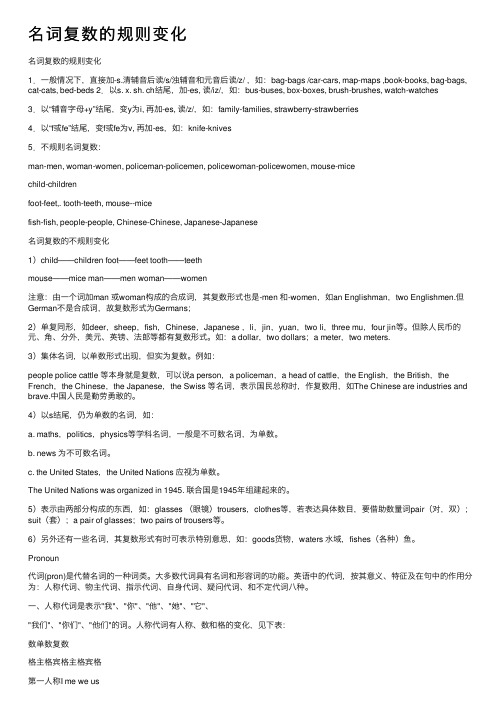
名词复数的规则变化名词复数的规则变化1.⼀般情况下,直接加-s.清辅⾳后读/s/浊辅⾳和元⾳后读/z/ ,如:bag-bags /car-cars, map-maps ,book-books, bag-bags, cat-cats, bed-beds 2.以s. x. sh. ch结尾,加-es, 读/iz/,如:bus-buses, box-boxes, brush-brushes, watch-watches3.以“辅⾳字母+y”结尾,变y为i, 再加-es, 读/z/,如:family-families, strawberry-strawberries4.以“f或fe”结尾,变f或fe为v, 再加-es,如:knife-knives5.不规则名词复数:man-men, woman-women, policeman-policemen, policewoman-policewomen, mouse-micechild-childrenfoot-feet,. tooth-teeth, mouse--micefish-fish, people-people, Chinese-Chinese, Japanese-Japanese名词复数的不规则变化1)child——children foot——feet tooth——teethmouse——mice man——men woman——women注意:由⼀个词加man 或woman构成的合成词,其复数形式也是-men 和-women,如an Englishman,two Englishmen.但German不是合成词,故复数形式为Germans;2)单复同形,如deer,sheep,fish,Chinese,Japanese ,li,jin,yuan,two li,three mu,four jin等。
但除⼈民币的元、⾓、分外,美元、英镑、法郎等都有复数形式。
名词的单复数变化规则
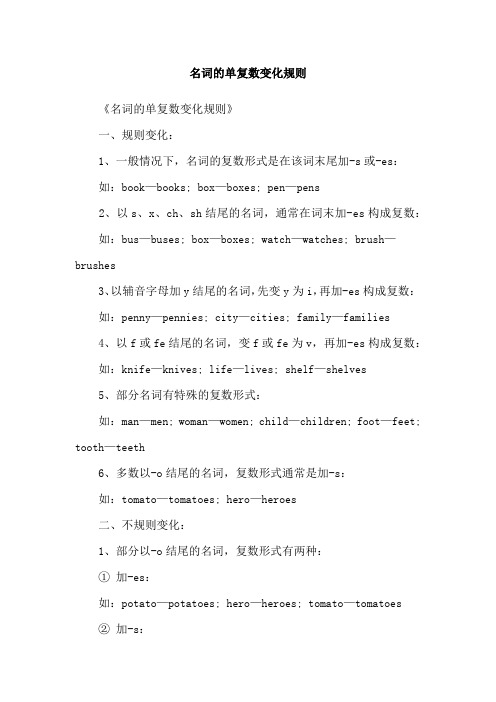
名词的单复数变化规则
《名词的单复数变化规则》
一、规则变化:
1、一般情况下,名词的复数形式是在该词末尾加-s或-es:
如:book—books; box—boxes; pen—pens
2、以s、x、ch、sh结尾的名词,通常在词末加-es构成复数:
如:bus—buses; box—boxes; watch—watches; brush—brushes
3、以辅音字母加y结尾的名词,先变y为i,再加-es构成复数:
如:penny—pennies; city—cities; family—families
4、以f或fe结尾的名词,变f或fe为v,再加-es构成复数:
如:knife—knives; life—lives; shelf—shelves
5、部分名词有特殊的复数形式:
如:man—men; woman—women; child—children; foot—feet; tooth—teeth
6、多数以-o结尾的名词,复数形式通常是加-s:
如:tomato—tomatoes; hero—heroes
二、不规则变化:
1、部分以-o结尾的名词,复数形式有两种:
①加-es:
如:potato—potatoes; hero—heroes; tomato—tomatoes
②加-s:
如:dynamo—dynamos; photo—photos; solo—solos 2、部分名词,形式上保持不变:
如:sheep—sheep; deer—deer; Chinese—Chinese 3、部分名词,复数形式与单数形式完全不同:
如:mouse—mice; goose—geese; louse—lice。
英语名词复数变化规则口诀
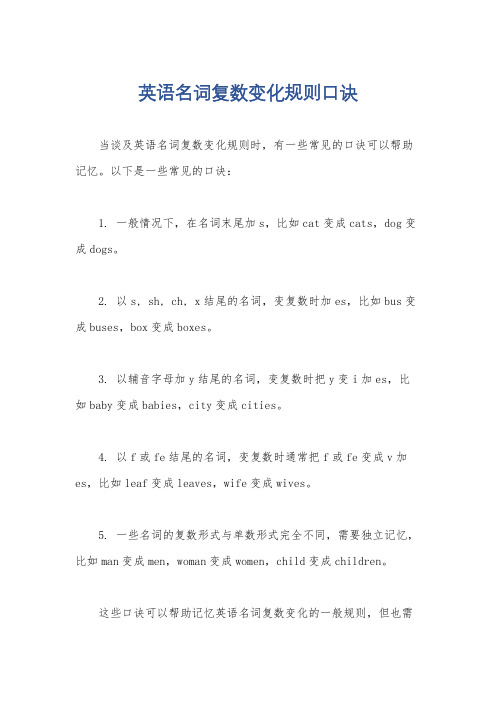
英语名词复数变化规则口诀
当谈及英语名词复数变化规则时,有一些常见的口诀可以帮助记忆。
以下是一些常见的口诀:
1. 一般情况下,在名词末尾加s,比如cat变成cats,dog变成dogs。
2. 以s, sh, ch, x结尾的名词,变复数时加es,比如bus变成buses,box变成boxes。
3. 以辅音字母加y结尾的名词,变复数时把y变i加es,比如baby变成babies,city变成cities。
4. 以f或fe结尾的名词,变复数时通常把f或fe变成v加es,比如leaf变成leaves,wife变成wives。
5. 一些名词的复数形式与单数形式完全不同,需要独立记忆,比如man变成men,woman变成women,child变成children。
这些口诀可以帮助记忆英语名词复数变化的一般规则,但也需
要结合实际练习和阅读中不断加深理解和记忆。
希望这些口诀对你有所帮助。
名词复数规则
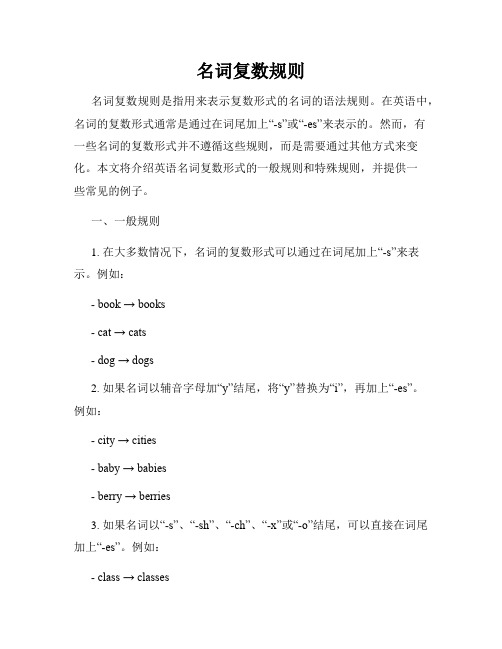
名词复数规则名词复数规则是指用来表示复数形式的名词的语法规则。
在英语中,名词的复数形式通常是通过在词尾加上“-s”或“-es”来表示的。
然而,有一些名词的复数形式并不遵循这些规则,而是需要通过其他方式来变化。
本文将介绍英语名词复数形式的一般规则和特殊规则,并提供一些常见的例子。
一、一般规则1. 在大多数情况下,名词的复数形式可以通过在词尾加上“-s”来表示。
例如:- book → books- cat → cats- dog → dogs2. 如果名词以辅音字母加“y”结尾,将“y”替换为“i”,再加上“-es”。
例如:- city → cities- baby → babies- berry → berries3. 如果名词以“-s”、“-sh”、“-ch”、“-x”或“-o”结尾,可以直接在词尾加上“-es”。
例如:- class → classes- watch → watches- box → boxes- potato → potatoes4. 以“-f”或“-fe”结尾的名词,通常将“f”或“fe”替换为“v”,再加上“-es”。
例如:- leaf → leaves- wife → wives- thief → thieves5. 以“-o”结尾的名词有两种情况:- 如果名词的最后一个音节是元音音素,在词尾直接加上“-s”。
例如:stereo → stereos- 如果名词的最后一个音节是辅音音素,在词尾加上“-es”。
例如:tomato → tomatoes二、特殊规则1. 有些名词的复数形式完全不同于其单数形式,而需要进行其他的变化。
例如:- man → men- woman → women2. 一些名词的复数形式与单数形式完全相同,没有变化。
例如:- sheep → sheep- fish → fish- deer → deer3. 一些名词的复数形式可以通过在前面加上“-en”或“-ren”来表示。
名词变复数规则变化
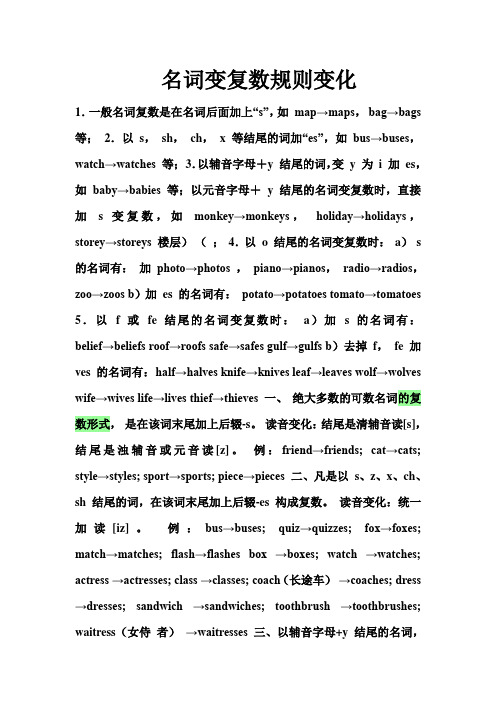
名词变复数规则变化1.一般名词复数是在名词后面加上“s”,如map→maps,bag→bags 等;2.以s,sh,ch,x 等结尾的词加“es”,如bus→buses,watch→watches 等;3.以辅音字母+y 结尾的词,变y 为i 加es,如baby→babies 等;以元音字母+y 结尾的名词变复数时,直接加s 变复数,如monkey→monkeys,holiday→holidays,storey→storeys 楼层)(;4.以o 结尾的名词变复数时:a)s 的名词有:加photo→photos ,piano→pianos,radio→radios,zoo→zoos b)加es 的名词有:potato→potatoes tomato→tomatoes 5.以 f 或fe 结尾的名词变复数时:a)加s 的名词有:belief→beliefs roof→roofs safe→safes gulf→gulfs b)去掉f,fe 加ves 的名词有:half→halves knife→knives leaf→leaves wolf→wolves wife→wives life→lives thief→thieves 一、绝大多数的可数名词的复数形式,是在该词末尾加上后辍-s。
读音变化:结尾是清辅音读[s],结尾是浊辅音或元音读[z]。
例:friend→friends; cat→cats; style→styles; sport→sports; piece→pieces 二、凡是以s、z、x、ch、sh 结尾的词,在该词末尾加上后辍-es 构成复数。
读音变化:统一加读[iz]。
例:bus→buses; quiz→quizzes; fox→foxes; match→matches; flash→flashes box →boxes; watch →watches; actress →actresses; class →classes; coach(长途车)→coaches; dress →dresses; sandwich →sandwiches; toothbrush →toothbrushes; waitress(女侍者)→waitresses 三、以辅音字母+y 结尾的名词,将y 改变为i,再加-es。
名词复数变化规则

名词
一、不可数名词,分割后可保持原来物品的属性不变的词,如水,肉类,饭类等,没有复数形式,前面也不可以加a或an。
二、可数名词有单数和复数两种形式。
复数的部分规则如下:
1.一般情况下,直接加-s,如:
book-books, bag-bags, cat-cats, bed-beds
2.以s. x. sh. ch结尾,加-es,如:
bus-buses, box-boxes, brush-brushes, watch-watches 3.以o结尾的名词:一般有生命的加es,没有生命的名词加s,如:有生命的:tomato—tomatoes potata—potatoes;
没有生命的:photo--photos
4.以“辅音字母y”结尾,变y为i, 再加-es,如:
family-families strawberry-strawberries
(不变的:monkey-monkeys,boy-boys,holiday-holidays)
5.以“f或fe”结尾,变f或fe为v, 再加-es,如:
knife-knives leaf——leaves scarf--scarves
6.不规则名词复数:
man-men, woman-women, policeman-policemen, policewoman-p olicewomen,child-children foot-feet,tooth-teeth fish-fish, people-people, Chinese-Chinese, Japanese-Japanes e,sheep—sheep ,deer—deer。
名词复数的规则变化

名词复数的规则变化一、一般变化⑴加s1.清辅音后读/s/; map-maps2.浊辅音和元音后bag-bags 读/z/; car-cars⑵以s,sh, ch ,x 等结尾的词加-es读/iz/ bus-buses watch-watches⑶以ce, se, ze, (d)ge等结尾的词加-s读/iz/ license-licenses⑷以辅音字母y结尾的词变y 为i 再加es读/z/ baby---babies二、其它名词复数的规则变化1) 以y结尾的专有名词,或元音字母+y 结尾的名词变复数时,直接加s变复数:如:two Marys the Henrysmonkey---monkeys holiday---holidays比较:层楼:storey ---storeys story---stories2) 以o 结尾的名词,变复数时:a. 加s,如:photo---photos piano---pianos radio---radios zoo---zoos;b. 加es,如:potato--potatoes tomato--tomatoesc. 均可,如:zero---zeros / zeroes3) 以f或fe 结尾的名词变复数时:a. 加s,如:belief---beliefs roof---roofs safe---safes gulf---gulfs;b. 去f,fe 加ves,如:half---halves knife---knives leaf---leaves wolf---wolveswife---wives life---lives thief---thieves;c. 均可,如:handkerchief: handkerchiefs / handkerchieves三、名词复数的不规则变化1)child---children foot---feet tooth---teeth mouse---mice man---men woman---women注意:与man 和woman构成的合成词,其复数形式也是-men 和-women。
名词的单复数变化规则
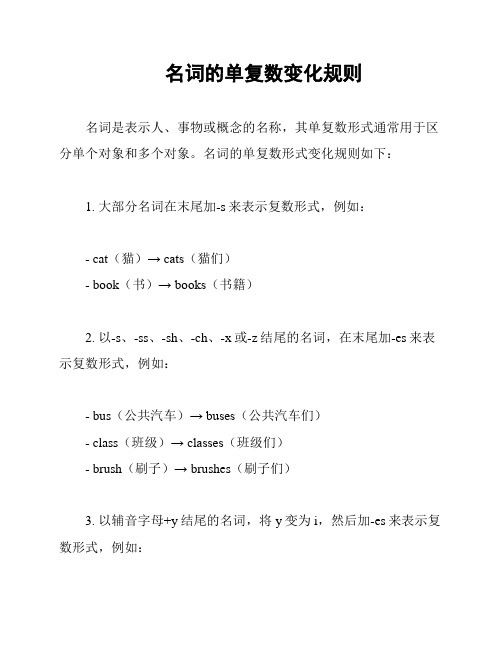
名词的单复数变化规则
名词是表示人、事物或概念的名称,其单复数形式通常用于区分单个对象和多个对象。
名词的单复数形式变化规则如下:
1. 大部分名词在末尾加-s来表示复数形式,例如:
- cat(猫)→ cats(猫们)
- book(书)→ books(书籍)
2. 以-s、-ss、-sh、-ch、-x或-z结尾的名词,在末尾加-es来表示复数形式,例如:
- bus(公共汽车)→ buses(公共汽车们)
- class(班级)→ classes(班级们)
- brush(刷子)→ brushes(刷子们)
3. 以辅音字母+y结尾的名词,将y变为i,然后加-es来表示复数形式,例如:
- baby(婴儿)→ babies(婴儿们)
- city(城市)→ cities(城市们)
4. 以-o结尾的名词,大多在末尾加-es来表示复数形式,例如:
- potato(土豆)→ potatoes(土豆们)
- tomato(番茄)→ tomatoes(番茄们)
5. 一些名词的复数形式与单数形式完全不同,需要进行特殊记忆,例如:
- child(孩子)→ children(孩子们)
- tooth(牙齿)→ teeth(牙齿们)
需要注意的是,不同名词的复数形式变化规则可能会有差异,
以上仅为一般规则,具体名词的复数形式变化还需根据各个名词的
特殊规定来进行记忆和应用。
希望以上内容对您有所帮助!。
英语名词的复数变化规则

英语可数名词的复数变化规则:1、一般情况下加S例如:book——booksruler—-rulershen——hens2、以s、x、ch、sh 结尾,加es例如:bus-—busesbox——boxeswatch—-watchesdish——dishes3、以元音字母+y结尾,加s (元音字母: a o e i u)例如:monkey-—monkeysholiday—-holidaystoy——toys4、以辅音字母+y结尾,去掉y,加ies例如:story——storiesbaby—-babies①直接加s5、以f、fe结尾有的②去掉f或fe,加ves③既可以直接加s,又可以去掉f、fe加ves➢以f、fe结尾,直接加s顺口溜:海湾农奴信酋长,悬崖证据在房顶。
gulf—-gulfs[ɡʌlf]海湾serf—-serfs[sɜːf]农奴、奴隶belief—-beliefs[bɪ'liːf]信chief-—chiefs [tʃiːf]酋长cliff—-cliffs[klɪf] 悬崖proof——proofs[pruːf]证据roof——roofs[ruːf]房顶➢以f、fe结尾,加es顺口溜:妻子持刀去宰狼,小偷吓得发了慌,躲在架后保己命,半片树叶遮目光。
wife——wives[waɪf] 妻子knife——knives[naɪf]小刀wolf-—wolves[wʊlf]狼thief——thieves[θiːf]小偷shelf——shelves[ʃelf] 架子self——selves[self] 自己life-—lives[laɪf]生命half——halves[hɑːf]一半leaf——leaves[liːf]树叶例如:myself——ourselvesyourself——yourselveshimself(herself)——themselves➢以f、fe结尾,既可以直接加s,又可以去掉f、fe加ves顺口溜:码头侏儒围围巾,手绢复数变二心。
名词复数形式变化的规则
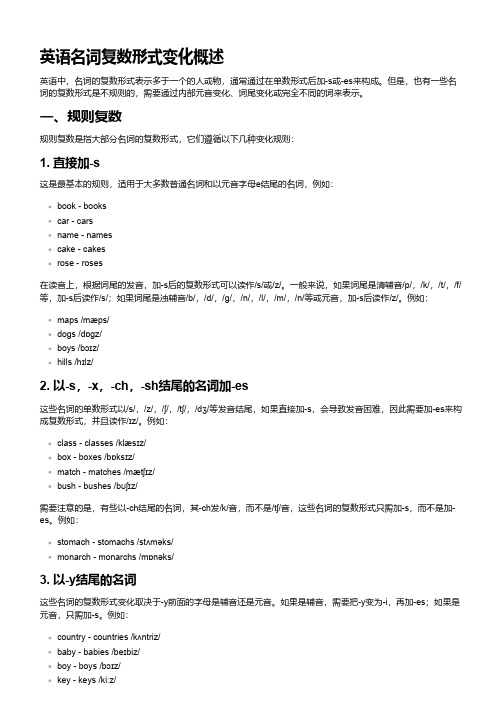
英语名词复数形式变化概述英语中,名词的复数形式表示多于一个的人或物,通常通过在单数形式后加-s或-es来构成。
但是,也有一些名词的复数形式是不规则的,需要通过内部元音变化、词尾变化或完全不同的词来表示。
一、规则复数规则复数是指大部分名词的复数形式,它们遵循以下几种变化规则:1. 直接加-s这是最基本的规则,适用于大多数普通名词和以元音字母e结尾的名词,例如:book - bookscar - carsname - namescake - cakesrose - roses在读音上,根据词尾的发音,加-s后的复数形式可以读作/s/或/z/。
一般来说,如果词尾是清辅音/p/,/k/,/t/,/f/等,加-s后读作/s/;如果词尾是浊辅音/b/,/d/,/g/,/n/,/l/,/m/,/n/等或元音,加-s后读作/z/。
例如:maps /mæps/dogs /dɒgz/boys /bɔɪz/hills /hɪlz/2. 以-s,-x,-ch,-sh结尾的名词加-es这些名词的单数形式以/s/,/z/,/ʃ/,/tʃ/,/dʒ/等发音结尾,如果直接加-s,会导致发音困难,因此需要加-es来构成复数形式,并且读作/ɪz/。
例如:class - classes /klæsɪz/box - boxes /bɒksɪz/match - matches /mætʃɪz/bush - bushes /bʊʃɪz/需要注意的是,有些以-ch结尾的名词,其-ch发/k/音,而不是/tʃ/音,这些名词的复数形式只需加-s,而不是加-es。
例如:stomach - stomachs /stʌməks/monarch - monarchs /mɒnəks/3. 以-y结尾的名词这些名词的复数形式变化取决于-y前面的字母是辅音还是元音。
如果是辅音,需要把-y变为-i,再加-es;如果是元音,只需加-s。
名词的复数形式变化规则

名词的复数形式变化规则:一规则变化(7 条)1.一般情况下,直接在名词后+ s例:book →books bag →bags tree →trees 2.—s,—ss , —sh ,-ch ,-x ,—z结尾→+ es例:bus →buses class →classes brush →brushes box →boxes buzz →buzzes watch →watches 3.辅音字母+ y 结尾→改y为i + es例:factory →factories baby →babies lady →ladies 4.元音字母+ y 结尾→+ s例:boy →boys key →keys monkey →monkeys 5.—f, —fe 结尾①一般情况下:-f,—fe 去掉→v + es例:leaf →leaves wife →wives knife →knives②—f,-fe →直接+ schief→chiefs gulf →gulfs safe →safes6.—o→三种情况⑴一般情况→+ s例:photo →photos piano →pianos⑵→+ espotato土豆→patatoes tomato西红柿→tomatoes7.—oo →+s例:zoo→zoos kangaroo →kangaroos二不规则变化( 10 个)①man →men ②woman →women③foot →feet ④tooth →teeth ⑤goose →geese⑥mouse →mice ⑦louse →lice⑧child →children ⑨ox →oxen ⑩German→Germans三单复数同形sheep 绵羊→sheep fish鱼→fish (fishes→强调种类)deer鹿→deer Chinese 中国人→Chinese Japanese日本人→Japanese。
名词复数形式的变化规则
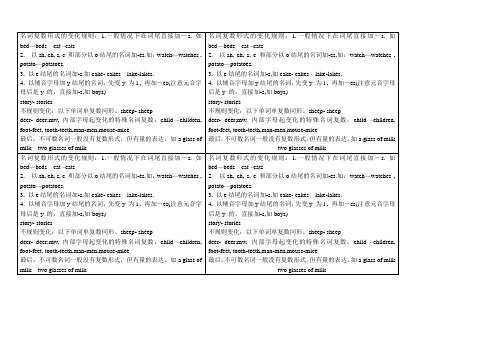
不规则变化:以下单词单复数同形。sheep- sheep
deer- deer;mw,内部字母起变化的特殊名词复数:child –children, foot-feet, tooth-teeth,man-men,mouse-mice
最后,不可数名词一般没有复数形式,但有量的表达。如a glass of milk two glasses of milk
但下列名词的复数形式只加-s,须记住:pianos钢琴,photos照片,zoos公园,bamboos竹子,radios收音机,studios摄影棚,cuckoos布谷鸟,solos独唱,tobaccos烟草,kilos公斤,discos迪斯科,cellos大提琴
还有些名词的复数形式加-es或-s都可以,它们是:zero零,buffalo水牛,Eskimo爱斯基摩人,volcano火山
名词复数形式的变化规则:1.一般情况下在词尾直接加-s.如bed—beds cat –cats
2.以sh, ch, s, c和部分以o结尾的名词加-es.如:watch—watches , potato—potatoes.
3.以e结尾的名词加-s.如cake- cakes lake-lakes.
4.以辅音字母加y结尾的名词,先变y为i ,再加-es(注意元音字母后是y的,直接加-s,如boys)
story- stories
不规则变化:以下单词单复数同形。sheep- sheep
deer- deer;mw,内部字母起变化的特殊名词复数:child –children, foot-feet, tooth-teeth,man-men,mouse-mice
最后,不可数名词一般没有复数形式,但有量的表达。如a glass of milk two glasses of milk
- 1、下载文档前请自行甄别文档内容的完整性,平台不提供额外的编辑、内容补充、找答案等附加服务。
- 2、"仅部分预览"的文档,不可在线预览部分如存在完整性等问题,可反馈申请退款(可完整预览的文档不适用该条件!)。
- 3、如文档侵犯您的权益,请联系客服反馈,我们会尽快为您处理(人工客服工作时间:9:00-18:30)。
名词复数形式的变化规则;1.大多数情况下,直接加s2.以 s x sh ch结尾的名词变复数,加es3. 以 f fe 结尾的名词变复数,把 f fe 变为ves.4. 以辅音字母加y 结尾的名词变复数,把y 变 i 再加es. 例如,family 以辅音字母l 加y 结尾,所以复数形式为families,boy也是以y 结尾的,但它是以元音字母o加y结尾的,所以复数形式为boys5. 有些以字母o 结尾的名词变复数加es,例tomato es,potato es6.还有一些不规则变化的,需要同学们分清记牢。
如sheep——sheep,child------ children二、练习题。
<一>、写出下列名词的复数形式1、orange2、class3、text4、monkey5、piano6、child 7、shelf 8、bed 9、country10、family 11、toy 12、foot13、Japanese 14、radio 15、photo16、army 17、tomato 18、fox19、woman 20、knife 22、sheep<二>、选择填空1、There on the wall .They are very beautiful.A. are photoesB. are photosC. is a photoD. is photos2. This kind of car made in Shanghai.A. is B .are C .were D .has3. There are four and two in the group.A. Japanese, Germen B Japaneses, GermenC. Japanese,German C.Japanese, Germans4. That’a art book.A. anB. aC. the D are5. The boys have got already.A. two breadB. two breadsC. two pieces of breadD. two piece of bread6. The old man wants .A. six boxes of applesB. six boxes of appleC. six box of applesD. six boxs of apples7. There some in the river.A. is ,fishB. are, fishsC. is, fishsD. are ,fish8. There two in the box.A. is watchB. are watchesC. are watchD. is watches9. We should clean twice a day.A .our tooth B. our toothsC.teethD.our teeth10.The _____ meeting room is near the reading room.A.teacherB.teacher’sC.teachers’D.teachers11. In Britain _____ are all painted red.A.letter boxesB.letters boxesC.letter boxD.letters box1选择填空1. They come from different ______A. countryB. countriesC. a countryD. countrys2. How many ______ do you see in the picture?A. tomatosB. tomatoesC. tomatoD. the tomato3. They are______.A . woman teachers B. women teachersC. women teacherD. woman teacher4. Would you like _______ ,please?A. two glass of waterB. two glasses of waterC. two glass of watersD. two glasses of waters5. Most of ______ live in _______.A. Germans, GermanB. German, GermenC. Germen, GermanyD. Germans, Germany6. There are some ______ in these _______.A.knifes…pencil-boxesB.knives…pencils-boxC.knives…pencil-boxD.knives…pencils-boxes7. ______ like ______ by air.A. Greens, travellingB. The Green, travelingC. The Greens, travelD. The Greens, traveling8. I wonder why ______ are interested in action films(武打片.A. the peopleB. peopleC. peoplesD. the peoples9. There is no ______ in the plate.A. applesB. orangesC. riceD. eggs2.填入所给名词的正确形式1. I have two_____ (knife2. There are many _____ here. (box3. There are many _____ on the road. (bus4. A few _____ are drawing on the wall. (boy5. The _____ are playing football now. (child 1 写出下列名词的复数形式。
1.bag _______2.orange _______3.family _______4.wish _______5.shelf _______6.knife _______7.key _______8.baby _______9.tooth _______ 10.foot _______ 11.woman _______ 12.sheep _______13.Japanese _______ 14.potato _______ 15.radio _______ 16.child _______ 17.fish _______ 18.photo _______ 19.Frenchman _______ 20.man doctor _______ 21.watch _______ 22. bus _______ 23. sheep _______ 24. foot _______2选择填空1. They come from different ______A. countryB. countriesC. a countryD. countrys2. How many ______ do you see in the picture?A. tomatosB. tomatoesC. tomatoD. the tomato3. They are______.A . woman teachers B. women teachersC. women teacherD. woman teacher4. Would you like _______ ,please?A. two glass of waterB. two glasses of waterC. two glass of watersD. two glasses of waters5. Most of ______ live in _______.A. Germans, GermanB. German, GermenC. Germen, GermanyD. Germans, Germany6. There are some ______ in these _______.A.knifes…pencil-boxesB.knives…pencils-boxC.knives…pencil-boxD.knives…pencils-boxes7. ______ like ______ by air.A. Greens, travellingB. The Green, travelingC. The Greens, travelD. The Greens, traveling8. I wonder why ______ are interested in action films(武打片.A. the peopleB. peopleC. peoplesD. the peoples9. There is no ______ in the plate.A. applesB. orangesC. riceD. eggs10. _______ are good for our health.A. TomatosB. TomatoesC. Tomato11. I like to eat cake with ______.A. cherriesB. cherryC.cherrys12. ______ and ______ are not friends.A. Foxs…wolfsB. Foxes…wolfsC. Foxes…wolves13. These are the ______ of our national ______.A. photos … heroesB. photoes … heroesC. photos … heros14. The ______ are running on the ______.A. deer … grassesB. deers … grassC. deer … grass15. I was so hungry and I ate two ______.A. bowls of noodleB. bowls of noodlesC. bowl of noodles3.填入所给名词的正确形式1. I have two_____ (knife2. There are many _____ here. (box3. There are many _____ on the road. (bus4. A few _____ are drawing on the wall. (boy5. The _____ are playing football now. (child4请用括号中名词的复数形式填空1 Look at those _______. (child2 I can see a __________ standing near the door. (policeman3 Do you want some ________ for dinner? (potato4 In autumn, you can see a lot of _______ on the ground.(leaf5 He has two _______.One is blue , the other is yellow.( box6 Two ________ live in this building .( family5选择正确的词形1 How many (radioes, radios can you see?2 There are 36 (boys, boies in my class.3 Look at those (sheeps, sheep.4 I don’t want (a, an old cup.5 Give me that (box, boxes, please.6将以下单复数句进行转换1 This is a knife. ______________________________________2 That is a tomato. ______________________________________3 That child is very good._____________________________________4 These are mice. ______________________________________5 Those are children. ______________________________________1、I want three white paper.A、piecesB、piece ofC、pieces of2、Do you want to drink much ?A、a milkB、milkC、milks3、This is room. It’s very big.A、Lily and Lucy’sB、Lily’s and Lucy’sC、Lily’s and Lucy4、We visited house yesterday.A、TomB、TomsC、Tom’s5、Do you want some for supper?A、a potatoB、potatoesC、potatos6、In autumn,you can see a lot of on the ground.A、leafB、leafsC、leaves7、My sister has two . One is old,the other is new.A、a watchB、watchsC、watches8、Best wishes to you for Day!A、Teacher’sB、Teachers’C、Teacher9、Many children like to go to the Palace on Sunday.A、ChildrenB、Children’sC、Childrens’。
